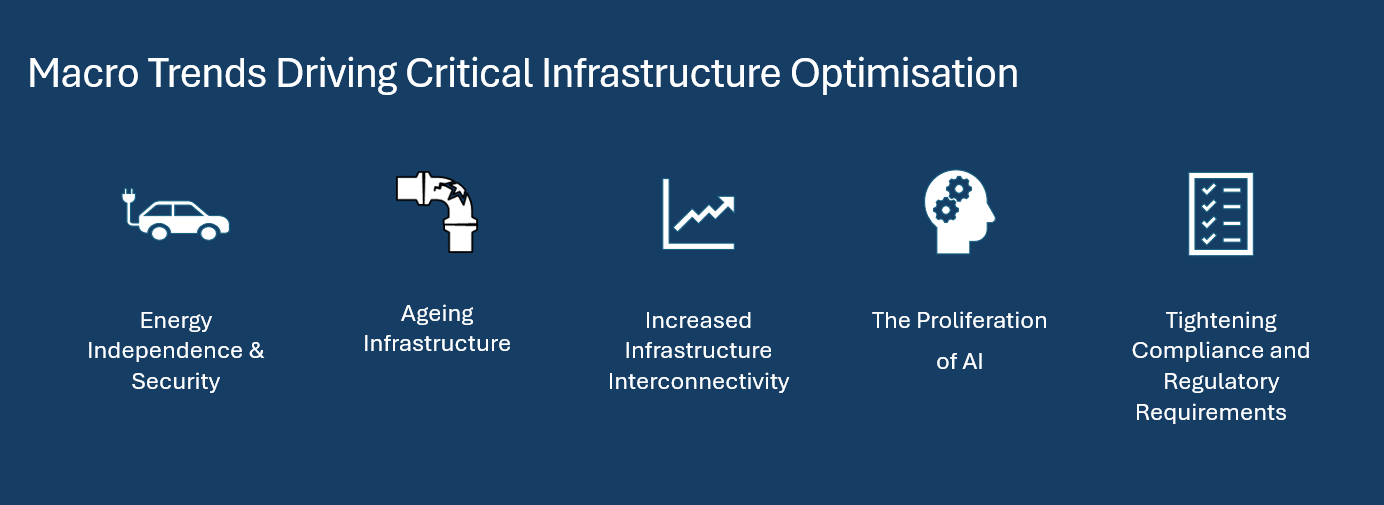
The Rising Opportunity in Critical Infrastructure Optimisation
By Jubril Ayanbunmi
Across the globe, the systems that power our lives — energy, water, transport and digital infrastructure — are under mounting pressure. Climate change, ageing assets, rising operating costs and soaring demand are testing resilience like never before. But a quiet revolution is underway: a transformation powered not by building more, but rather by harnessing data, sensors and software.
Strained foundations create the optimisation imperative
In the developed world, many infrastructure assets are well past their prime. In the US, the average bridge is 43 years old, with 1 in 9 classified as structurally deficient. In the UK, a study by the RAC Foundation found that nearly 3,000 bridges are unable to carry the heaviest legal loads.
Meanwhile, climate volatility is adding further disruption. In June this year a heat wave led to rail operators in Pennsylvania and Washington DC slowing or halting trains due to the risk of warped tracks and damaged overhead wiring. Extreme temperatures, floods and droughts are degrading asset performance, straining maintenance teams and driving up unexpected costs. These challenges are converging to expose the vulnerabilities of ageing infrastructure and highlight the urgent need for more resilient, intelligent systems.
Traditionally, infrastructure investment focused on building new assets. But many of today’s most exciting innovations are being driven by digital tools, making existing infrastructure more intelligent and efficient.
Critical infrastructure optimisation combines technologies such as AI, IoT, digital twins and predictive analytics to improve asset performance, reduce costs and build resilience. These tools are now being deployed across traditional infrastructure and infrastructure-like sectors:
- Energy grids use AI to forecast demand and automatically shift to cheaper or cleaner power sources when beneficial.
- Water utilities detect and prevent leaks in real time whilst optimising chemical disinfectant usage to improve water quality.
- Data centres deploy AI-enabled cooling systems that reduce energy consumption by 30–40% and importantly increase resiliency.
- Transport fleets are using smart routing and monitoring to cut fuel use and emissions and reduce accident risk.
This digital optimisation also improves regulatory compliance across all sectors by enabling real-time reporting. For example, AI technology is now being integrated into drones to remotely monitor and detect unexpected emissions across remote assets. Beyond cost-cutting, optimisation increases system reliability, ensuring critical services stay online when it matters most.
As infrastructure becomes more connected, optimisation tools are being applied to both virtual and physical assets to identify cascading vulnerabilities. This capability is vital as, in a hyperconnected ecosystem, a failure in one domain, such as an electricity outage, can quickly impact core services such as hospitals, water treatment plants and data centres.
The benefits of infrastructure optimisation are remarkable. In a recent report, Deloitte estimates that by 2050, AI-enabled, resilient infrastructure could prevent up to US$70 billion in annual losses from natural disasters, equivalent to 15% of total annual infrastructure damages worldwide. For instance, in Wroclaw, Poland, the municipal water utility is leveraging an AI-powered system to improve infrastructure planning. By analysing variables like pipe age, material, and external stressors such as proximity to tram lines, the system can forecast potential failures with up to 90% accuracy, enabling targeted, cost-effective upgrades across water networks, especially under budget constraints.1
A smarter road forward: the digital future of infrastructure
Governments and companies face mounting pressure to address ageing infrastructure, advance the energy transition and build climate resilience, all amid tightening budgets and spending cuts. Optimising critical infrastructure is becoming essential for sustainable, long-term growth.
Baird Capital believes that there is tremendous opportunity for businesses that combine digital and physical infrastructure to deliver critical insights, improve service levels and support asset owners with maintenance and repair. We view the following macro trends as key drivers of the investment opportunity:

These themes are driving demand for solutions that strengthen infrastructure resiliency.
Businesses that offer digitally enabled, end-to-end capabilities and have recurring/reoccurring touchpoints across asset lifecycles are well positioned to meet this demand and capture value as they support the long-term modernisation of critical infrastructure.
A prime example of a business model meeting these demands is Cleanwater1, which offers water quality solutions to the aging water and wastewater infrastructure markets. Cleanwater1’s product portfolio is focused on improving water quality while also optimizing cost and efficiency for end users which provides resiliency to critical water and wastewater infrastructure. Its products strengthen critical water infrastructure and make it more reliable. For instance, its Microclor system optimises water treatment processes and increases system reliability by producing chlorine on site, helping utilities save money, reduce labour, and get the most from their infrastructure.
At Baird Capital, we focus on partnering with product, technology and services businesses, like Cleanwater1, that support critical infrastructure and deliver a clear ROI to asset owners and managers. With a 40+ year track-record in the broader industrial technology market and a global platform with teams in the US and UK, we are well positioned to support companies that bring technology-driven solutions to manage and optimise critical infrastructure.
Contact a member of the team to discuss further.










